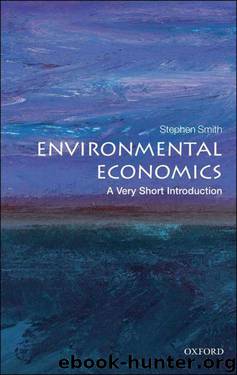Environmental Economics: A Very Short Introduction (Very Short Introductions) by Stephen Smith

Author:Stephen Smith [Smith, Stephen]
Language: eng
Format: epub, azw3, mobi
Publisher: Oxford University Press
Published: 2011-09-21T16:00:00+00:00
Chapter 4
Economic information and values in environmental policy decisions
LORD DARLINGTON. What cynics you fellows are!
CECIL GRAHAM. What is a cynic? (Sitting on the back of the sofa.)
LORD DARLINGTON. A man who knows the price of everything and the value of nothing.
CECIL GRAHAM. And a sentimentalist, my dear Darlington, is a man who sees an absurd value in everything, and doesn’t know the market price of any single thing.
Oscar Wilde, Lady Windermere’s Fan (1892)
Chapter 2 described how an economist might determine the desirable level of pollution control, by comparing the costs and benefits of each successive unit of pollution abatement. Some of these costs and benefits are relatively easily measured. Many of the costs of pollution abatement, for example, are the costs of obtaining and installing pollution-control equipment, for which prices are readily available. Others, however, are much less straightforward to include in any cost–benefit analysis. Air pollution, for example, causes health damage. This harm needs to be weighed up against the costs of installing pollution-control equipment, but how do we assess the value of the harm done, in the form of poor health and, possibly, premature death, on a basis that can be compared with the costs of pollution control? In between these extremes, there are many other effects – either costs of control, or benefits of reduced pollution, which cannot be readily read off from available market prices. For example, if high taxes on motor fuel are seen as a way to reduce traffic pollution or congestion, how do we assess the costs to people of forgoing journeys they would otherwise want to make? And if part of the benefit of environmental policy is the preservation of certain natural habitats, how do we value the amenity benefits for walkers and birdwatchers of the unspoiled environment, or the benefits of preserving some biodiversity that could otherwise have been lost?
More fundamentally, in what sense is cost in terms of money values the right yardstick to be using in comparing the advantages and disadvantages of taking action to control pollution? When we consider measures to protect an unspoiled wilderness, or conservation measures that may prevent the extinction of rare birds (or, for that matter, rare beetles), can we really summarize the value of what we conserve, or the destruction that we avoid, in terms of market prices and money values?
Download
Environmental Economics: A Very Short Introduction (Very Short Introductions) by Stephen Smith.azw3
Environmental Economics: A Very Short Introduction (Very Short Introductions) by Stephen Smith.mobi
This site does not store any files on its server. We only index and link to content provided by other sites. Please contact the content providers to delete copyright contents if any and email us, we'll remove relevant links or contents immediately.
Bad Blood by John Carreyrou(6552)
Rich Dad Poor Dad by Robert T. Kiyosaki(6403)
Principles: Life and Work by Ray Dalio(6213)
Playing to Win_ How Strategy Really Works by A.G. Lafley & Roger L. Martin(5922)
Management Strategies for the Cloud Revolution: How Cloud Computing Is Transforming Business and Why You Can't Afford to Be Left Behind by Charles Babcock(4527)
The Confidence Code by Katty Kay(4187)
Thinking in Bets by Annie Duke(4153)
American Kingpin by Nick Bilton(3757)
Delivering Happiness by Tony Hsieh(3365)
Project Animal Farm: An Accidental Journey into the Secret World of Farming and the Truth About Our Food by Sonia Faruqi(3177)
The Power of Habit by Charles Duhigg(3062)
Brotopia by Emily Chang(3001)
The Tyranny of Metrics by Jerry Z. Muller(3000)
Mastering Bitcoin: Programming the Open Blockchain by Andreas M. Antonopoulos(2981)
The Marketing Plan Handbook: Develop Big-Picture Marketing Plans for Pennies on the Dollar by Robert W. Bly(2975)
I Live in the Future & Here's How It Works by Nick Bilton(2935)
The Content Trap by Bharat Anand(2860)
Building a StoryBrand by Donald Miller(2842)
Applied Empathy by Michael Ventura(2839)
